
Analyzing plant-based meat & seafood sales
Dive deep into sales and consumer data for plant-based meat and seafood. Find key category insights, size, sales growth drivers, purchase dynamics, and consumer insights.
The state of the sector
The U.S. plant-based meat and seafood retail sector is significantly larger than it was just a decade ago. Products that target meat-eating consumers by more closely replicating conventional meat’s taste, texture, and functionality are responsible for much of the growth. When GFI began tracking plant-based meat and seafood sales in U.S. retail, we sized the 2017 market at $682 million, according to SPINS data. In 2024, the market was worth $1.2 billion.
Against this backdrop of long-term progress, recent years in the U.S. have been characterized by declining retail dollar and unit sales and increased average unit prices. In 2024, plant-based meat and seafood dollar sales decreased seven percent, while unit sales decreased 11 percent. The rate of sales decline was slower in 2024 than in 2023. For context, total food and beverage and the conventional meat and seafood category saw modest increases in both dollar and unit sales in 2024 after several years of contracting unit sales.
These metrics help reveal the industry’s progress toward achieving consumer adoption of plant-based meats at the scale needed to realize their real-world environmental, public health, and animal welfare advantages over their animal-based counterparts. To that end, GFI carefully tracks these evolving metrics as part of our ongoing work to develop the roadmap for a more sustainable, secure, and just protein supply.
Challenging market and consumer forces
Several factors contributed to trends in recent years. Most recently, elevated inflation across the food and beverage space, which was more extreme than in other sectors, squeezed consumer budgets and limited their willingness to purchase premium-priced products. This includes plant-based meat and seafood products, which often cost two to three times more than their conventional counterparts.
While 2024 saw inflation slow and consumer spending start to rebound in some categories and channels, consumers continue to express concern and frustration about grocery costs and price sensitivity continues to be a challenge for plant-based meat and seafood. Research by Kroger, the Plant Based Foods Institute, and 84.51° found that 28 percent of Kroger shoppers who cut back on plant-based foods between 2023 and 2024 said the products no longer fit their budgets, up 12 percentage points over the previous year. A December 2024 survey conducted by Morning Consult on behalf of GFI found that among consumers who had tried plant-based meat but not eaten it in the past year, 29 percent indicated that price was a top reason (up over the past year and second only to simply preferring animal meat). Beyond price, taste does not meet expectations and remains among the top drivers of consumers leaving the category.
These factors have contributed to sales declines, leading to plant-based meat and seafood products contending with shrinking shelf space as retailers worked to optimize assortments. According to SPINS, plant-based meat total distribution points dropped nine percent in the conventional multi-outlet (MULO) channel and 15 percent in the natural channel in 2024. Notably, distribution in the refrigerated department was down 12 percent in the conventional multi-outlet (MULO) channel, suggesting that products are becoming harder to find in the sections of the store (specifically, co-located with fresh conventional meat) where consumers prefer to see them and where velocities tend to be higher.
Positive signs in the market
SPINS data shows signs of stabilization and bright spots in the plant-based meat and seafood retail market in 2024.
- Velocities improved. While distribution declined, velocities improved, suggesting product assortments are becoming better optimized. In the natural channel, dollar velocity increased 12%, while in the conventional multi-outlet (MULO) channel, dollar velocity was up 2%.
- Price increases moderated. Average retail prices for plant-based meat and seafood increased 4%, slower growth than the previous two years. However, this was higher than the 1% increase in the price of animal meat, and plant-based meat and seafood products remain at significant price premiums to animal equivalents.
- Repeat rates were steady. The percentage of U.S. households buying plant-based meat was 13%, down from 15% in 2023. However, repeat rates have been relatively constant over recent years, suggesting that a core group of consumers remains engaged.
- Market shares were higher in some channels and formats. In the natural channel, the plant-based meat and seafood share of packaged meat (excluding random weight) dollar sales was 8%, compared to 1.7% overall. Some meat types and formats also enjoy higher shares. For example, we estimate that plant-based beef patty products held a 4-5% share of total retail packaged beef patty dollar sales.
- New products were launched. New and reformulated products and adjustments to packaging and marketing reflect brands’ learning and optimization to better meet consumer needs as the market evolves.
The opportunity remains, but there is work to do
The plant-based meat and seafood category remains a sizable market with significant potential. With over a billion dollars in U.S. retail sales, according to SPINS, and $289 million in U.S. broadline distributor foodservice sales, according to Circana, plant-based meat and seafood is an emerging category with meaningful consumer reach in a country where nearly every household purchases conventional meat.
The runway for plant-based meat is considerable. According to SPINS, only 13 percent of households purchased plant-based meat and seafood in 2024 and did so on average only every couple of months. A December 2024 survey conducted by Morning Consult on behalf of GFI found that almost 7 in 10 U.S. adults have never tried plant-based meat, have not eaten it recently, or eat it infrequently (less than a few times a year).
There is a large market opportunity for the plant-based meat category to increase penetration and frequency. This is demonstrated by consumer aspirations to reduce meat consumption and stated openness to plant-based meat as well as the potential of innovation to address key barriers around taste and affordability and deliver a compelling value proposition to consumers. A study conducted by GFI in 2024 found over two-thirds of U.S. consumers aged 18 to 59 are open to consuming plant-based meat in the future. Plant-based meat appeal is not limited to vegetarians, vegans, or even flexitarians. A majority of omnivores–representing two-thirds of the population–are also interested and recognize various benefits to adding plant-based meat to their diets, like health and nutrition.
While there’s a sizable runway for the plant-based meat category, growth is not inevitable. Aspirations abound for the plant-based meat and seafood industry to play a meaningful role in sustainably and efficiently feeding billions of people, mitigating the global impacts of climate change, and protecting public health. Yet there are signals that, for the market to see sustained growth, products need to better deliver on the key consumer drivers of taste and price while offering clear incentives for consumers to switch, such as compelling health benefits.
This analysis page will largely leverage U.S. retail sales data from SPINS commissioned by GFI and the Plant Based Foods Association to examine the latest trends in the plant-based meat and seafood category, frame the current state of the market, and explore what key opportunities lie ahead.

Overall sales performance
After a decade of growth, the plant-based meat and seafood category in U.S. retail experienced both dollar and unit sales declines over the past three years. These declines were larger than those experienced by conventional meat and the total food and beverage sector. They were influenced by both macroeconomic factors and remaining opportunities to meet consumer needs in the category.
In 2024, the plant-based meat and seafood category was worth $1.2 billion in U.S. retail. Compared to the previous year, the category experienced declines in dollar (-7 percent) and unit (-11 percent) sales. The rates of sales decline were slower in 2024 than in 2023.

Meanwhile, total food and beverage dollar sales grew two percent, driven by price increases, while unit sales held flat. Conventional meat dollar sales increased four percent, while unit sales increased three percent. Following unit declines in 2023, conventional meat unit sales landed at roughly the same level as in 2022. Average price per unit increases for conventional meat and seafood (+1 percent) and total food and beverage (+2 percent) were lower than for plant-based meat and seafood (+4 percent).
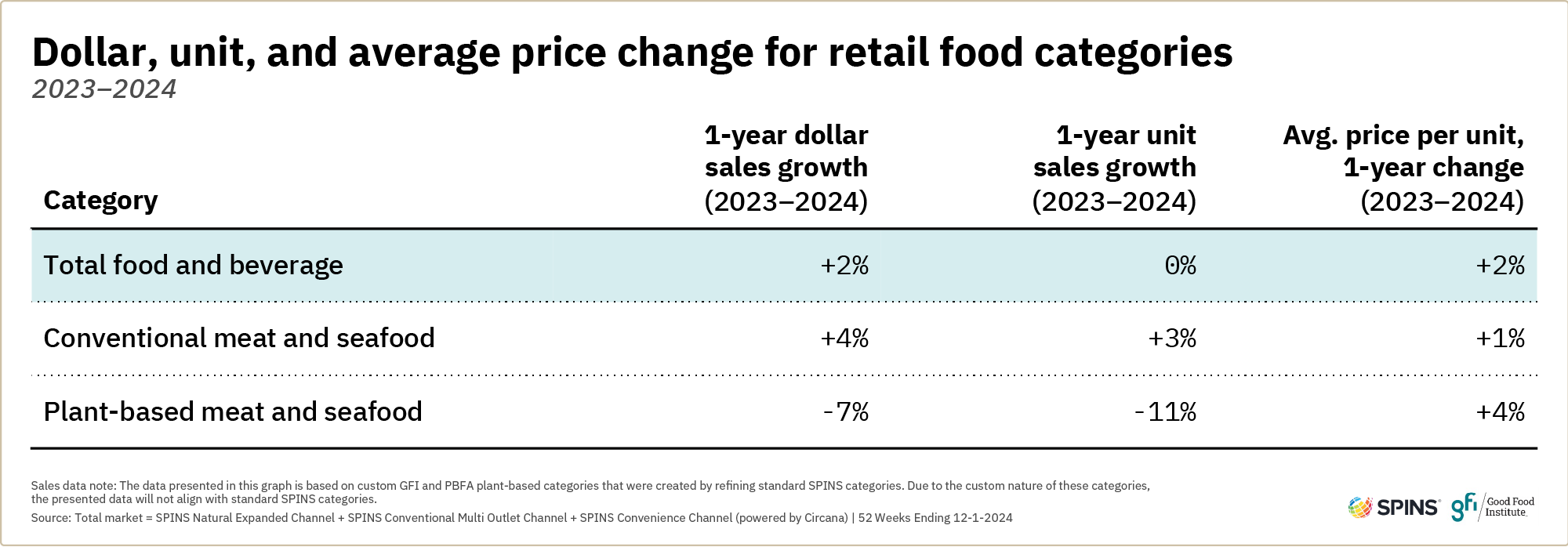
In 2024, plant-based meat and seafood’s dollar share was 1.7 percent of total retail packaged meat dollar sales, or approximately 0.8 percent of the total meat category, including random-weight meat. This underscores the nascency—and potential—of the category. For reference, plant-based milk has grown to represent 14 percent of total fluid milk dollar sales, and other emerging categories like plant-based creamers and plant-based protein liquids and powders enjoy a dollar share above five percent in their respective categories.
Department
The refrigerated segment led plant-based meat and seafood sales declines in 2024. This continued the shift of sales from refrigerated to frozen, where the majority of plant-based meat and seafood sales occur. Disproportionate losses in the refrigerated segment appeared to be driven by larger distribution losses. Meanwhile, price increases hit both departments.
It should be noted that the segment classification in the SPINS dataset may not always reflect where a given product is merchandised in the store (for example, a frozen product could be sold in the refrigerated department). These discrepancies may drive some of the apparent changes in the relative sizes of the refrigerated and frozen segments. However, the general trend of sales shifting from refrigerated to frozen is well-recognized in the category.
Shelf-stable products represent a very small share of the plant-based meat category and experienced significant declines in 2024. This was largely due to the discontinuation of the top-selling product line in that segment.
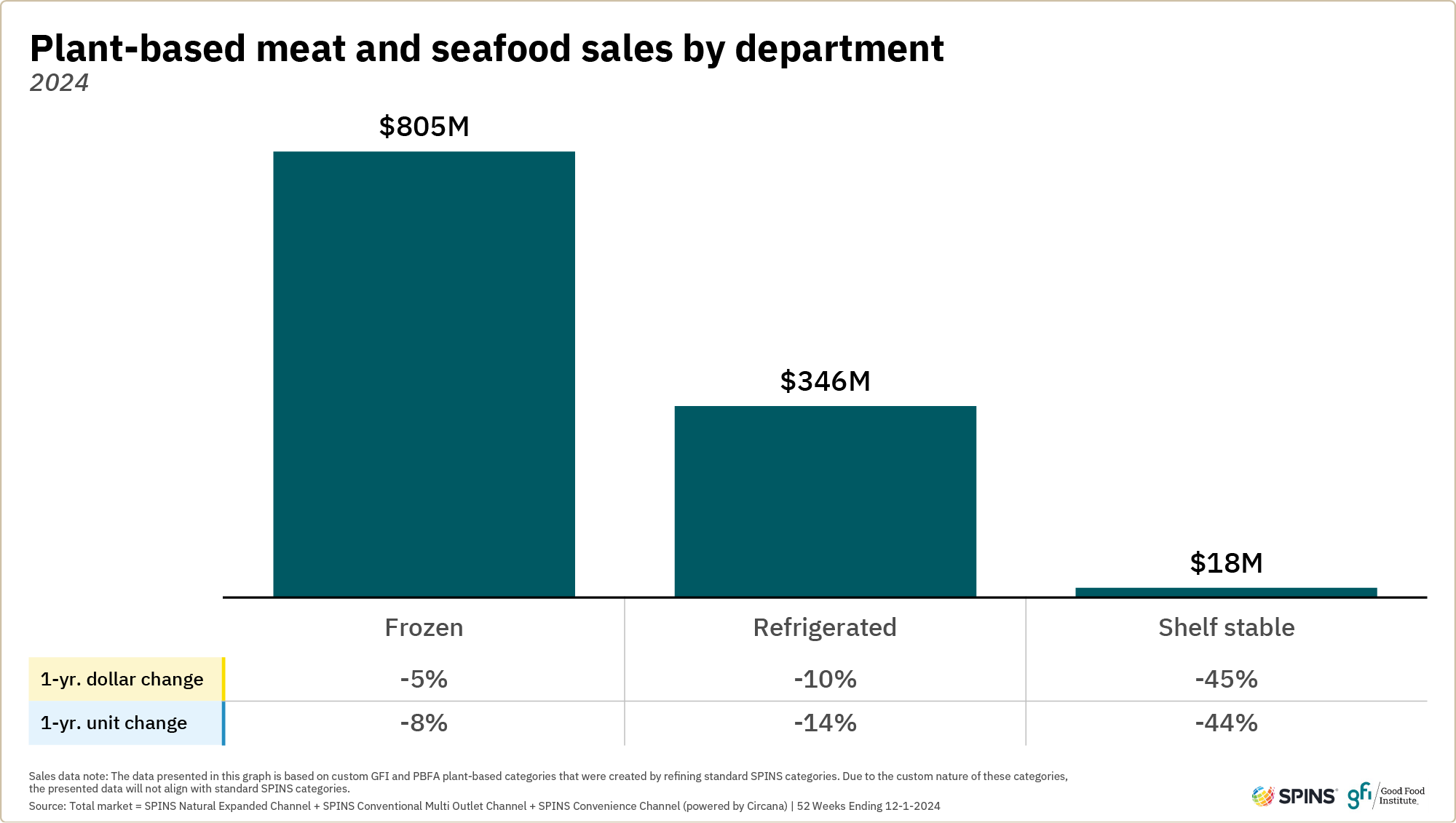
Animal-type
From an animal-type perspective, all subcategories saw sales decline in 2024. The top three segments—plant-based beef, chicken, and pork—made up nearly 90 percent of total category sales.
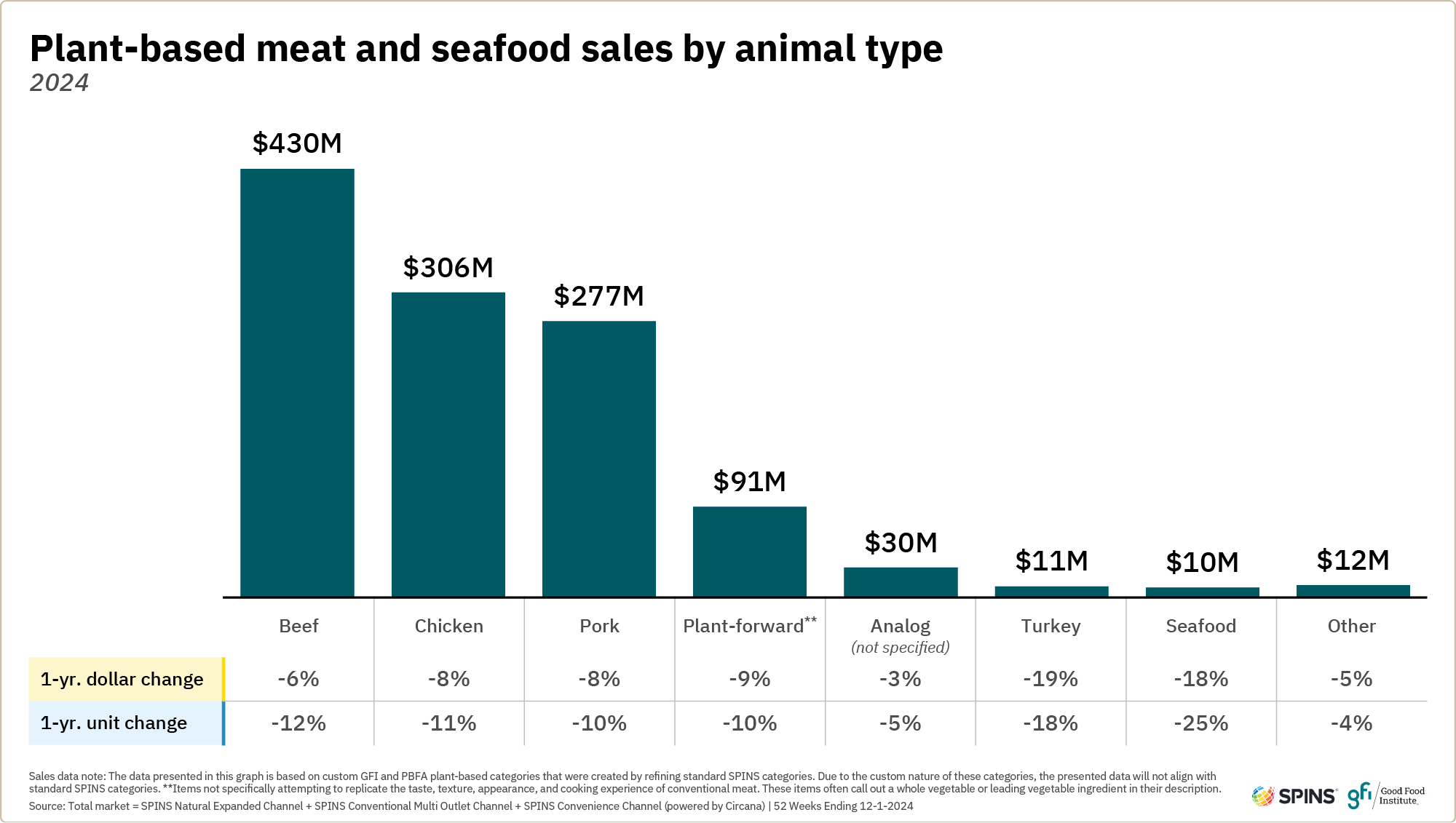
Distribution declines were a major source of volume losses for the top three animal types. However, velocities showed improvement, with dollar velocities growing for each of the top three animal types. Average prices per unit grew in the single-digit percentages for the top three segments, and plant-based beef led the way with a seven percent increase.
Despite losses, the top-selling plant-based meat and seafood animal types account for shares of their respective subcategories that are notably higher than the overall plant-based meat and seafood category share. We estimate that plant-based chicken, beef, and pork products each hold a roughly two to three percent dollar share of their respective retail packaged meat categories, compared to the 1.7 percent share plant-based meat and seafood holds of overall retail packaged meat dollar sales.
**”Plant-forward” refers to meat alternatives that are primarily whole vegetables or highlight whole plant ingredients as primary components. Examples include bean burgers, cauliflower wings, or jackfruit shreds. Generally, these products do not attempt to fully replicate the taste, texture, appearance, and experience of conventional meat.
Note: Tofu and tempeh items are not captured in the retail data in above sections covering plant-based meat and seafood. Instead, they are reported in a separate category—tofu, tempeh, and seitan. See data from that category, and many others across plant-based foods, on U.S. retail market insights for the plant-based industry.
Product format
Most product formats saw dollar and unit sales decline in 2024. Shreds, chunks, strips and filets, steaks, and cutlets were notable exceptions, both experiencing dollar and unit growth.
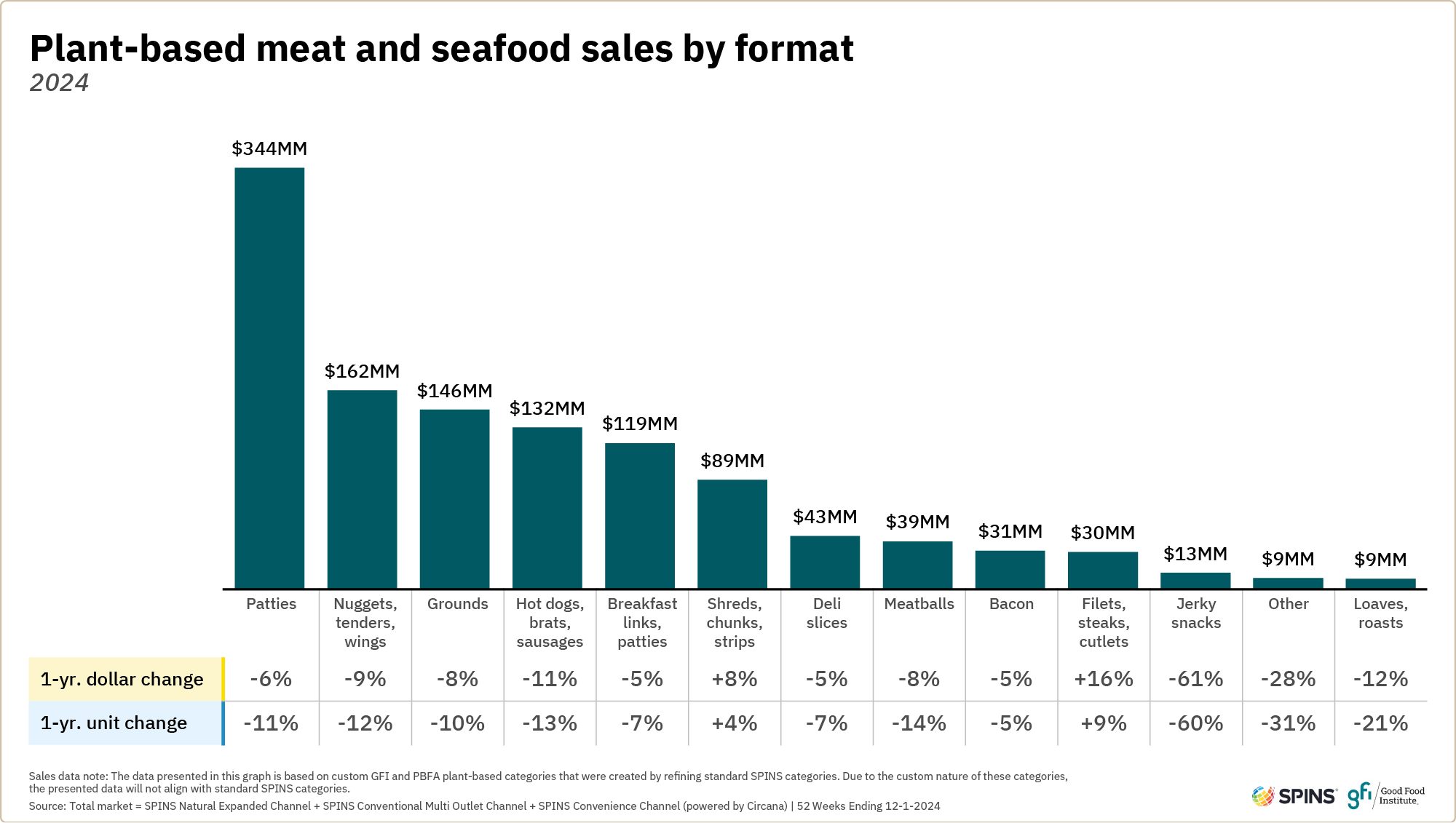
As with animal-type sales, distribution declines were the primary source of volume loss in 2024 for most format types. Meanwhile, price increases elevated dollar sales relative to unit sales for the top segments, particularly patties and nuggets, tenders, and wings. Jerky snacks saw significant declines as the top-selling product line in the category was discontinued.
On the other hand, shreds, chunks, and strips growth was fueled by distribution gains as products launched in the past couple of years continued to expand in the market. Filets, steaks, and cutlets experienced modest distribution gains and meaningful dollar and unit velocity increases. This segment also saw an uptick in innovation in recent years as manufacturers expanded the plant-based meat and seafood category to new and different eating occasions and product functionalities. Biomass fermentation products (e.g., fungi-based) have helped drive this expansion.
Similar to the top-selling plant-based meat and seafood animal types, the top-selling formats account for shares of their respective subcategories that are notably higher than the overall plant-based meat and seafood category share. We estimate that plant-based patties hold a six to seven percent share of total retail packaged meat patty dollar sales, compared to the 1.7 percent share plant-based meat and seafood holds of overall retail packaged meat dollar sales. Plant-based breakfast links and patties hold a roughly three to four percent dollar share, and plant-based nuggets, tenders, and wings hold a roughly two to three share of their respective packaged meat subcategories.

Key drivers
All three levers of retail sales—price, distribution, and velocity—impacted the trajectory of plant-based meat and seafood sales in 2024. Notably, distribution declines were the primary driver of plant-based meat sales decreases across channels and segments, while velocities stabilized or increased. Across the category, price increases resulted in dollar sales declining slower than unit sales. With sales declines slowing and improvement in key metrics like velocity, there are signs of opportunity to return the category to growth.
Price
Inflation remains a driver of dynamics in the food and beverage industry and the plant-based meat and seafood category. In 2024, prices continued to increase, although at more modest rates than in 2023. The average retail price for plant-based meat and seafood increased four percent, compared to a one percent increase for conventional meat and seafood.
While price increases in frozen plant-based meat and seafood significantly outpaced refrigerated in 2023, they were more in line with each other in 2024. Since the frozen department makes up 68 percent of plant-based meat and seafood unit sales, this contributed to the overall rate of category price growth slowing.
It’s critical to note that price increases not only drive dollar sales relative to unit sales but also influence consumer decisions at the shelf. For a category like plant-based meat and seafood, which is regularly two to four times more expensive pound for pound compared to conventional meat, grocery inflation poses an added challenge. Consumers with tight budgets are less likely to opt for these premium-priced products. Bringing down prices across the category will play a meaningful role in encouraging regular uptake by consumers.
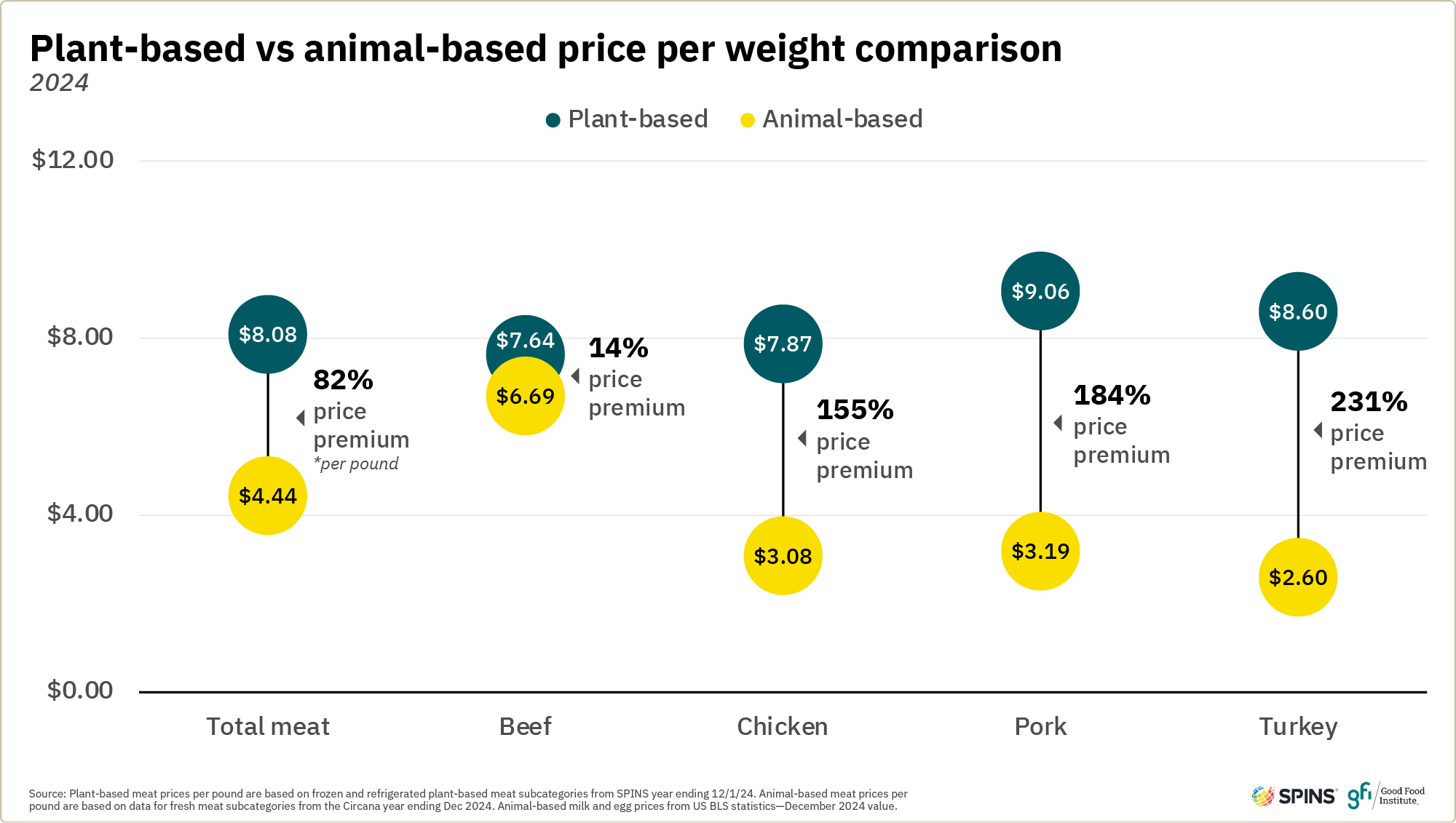
Distribution
In recent years, much of the dollar and unit growth in the plant-based meat and seafood category could be attributed to distribution gains. New products and brands were hitting the shelves for the first time, and early success led to expanded distribution into major retailers nationwide. This trend shifted in 2023 and 2024.
- Distribution declined in 2023 and 2024 after multiple years of expansion. In 2024, SPINS data shows distribution fell 9%in the conventional multi-outlet (MULO) channel and 15% in the natural channel. The refrigerated segment outpaced the frozen segment in distribution losses in 2024.
- Distribution impacts consumers’ ability to find plant-based meat. In a December 2023 survey conducted by Morning Consult on behalf of GFI, 26% of Americans said plant-based meat is ‘not too’ or ‘not at all’ easy to find in grocery stores. Of consumers who eat plant-based meat monthly or more, 56% said they buy it at their usual grocery store, but 26% said they had to go to a different grocery store to find it. This suggests that some plant-based meat purchases may be lost because consumers are not able to (easily) find products.
- Store sets must do more with less. Distribution declines mean fewer products are responsible for the sales volume of the entire category. Just as distribution growth can be a boon to an industry, distribution losses and assortment shrinkages can hinder growth. That said, shelf consolidation can also be an opportunity for brands that can maintain shelf space—if their products are good enough to earn repeat purchases.
- Innovation continues to influence what’s on the shelf. Despite overall distribution losses in 2024, the category continued to see new brands, flavors, and product formats (such as steaks, filets, and cutlets) expand in the market. While reducing category assortment in retail stores surely contributes to sales declines in the short term, optimizing assortments such that only the highest-performing products remain on the shelf could help direct consumers to products that best meet their needs. This could help build a more solid foundation for repeat purchases in the long term.
Velocity
Velocity—dollar or unit sales per point of distribution—is a metric for how effectively products are turning on the shelf. GFI’s analysis of data from SPINS reveals:
- Reduced distribution and optimized assortments appear to have bolstered velocity in plant-based meat and seafood. In 2024, plant-based meat and seafood experienced velocity gains following significant declines in 2023. In the natural channel, dollar velocity increased 12% and unit velocity increased 5%. In the conventional multi-outlet (MULO) channel, dollar velocity increased 2% while unit velocity declined by 1%. The dollar velocity gains in the natural channel were bolstered by price increases.
- Velocity in the refrigerated aisle rebounded. In 2024, the refrigerated segment experienced dollar velocity growth across channels (as distribution was lost), a change from 2023 when velocities were down significantly. For the frozen segment, velocities were up moderately in the natural channel and down slightly in the multi-outlet (MULO) channel.
Despite continued challenges around distribution losses and price increases, clear opportunities remain for this category to rebound and grow, particularly by focusing on improving taste and price and creating a more compelling value proposition for consumers.

Consumer purchase dynamics
One contributor to sales declines in the plant-based meat and seafood category was that some households that had previously purchased in the category did not do so in recent years. Re-engaging lapsed consumers while reaching new ones—by improving taste and texture, improving affordability, and emphasizing the value proposition that plant-based meat offers consumers—will be crucial to the category’s success.
Household penetration and repeat rates
In 2024, 13 percent of U.S. households purchased at least one product in the plant-based meat and seafood category, according to SPINS. While this is not an insignificant amount of engagement, it is less than the plant-based milk category, which had 40 percent household penetration, and much less than the conventional meat category, which boasted 97 percent household penetration.
Household penetration rates have fallen for the plant-based meat and seafood category since reaching a high of 20 percent in 2021. Meanwhile, repeat rates for households purchasing in the category have remained relatively stable over the last few years.
- Some households did not purchase in the category in 2024 despite doing so in 2023, but many are open to repurchasing in the future. Lapsed shoppers played a meaningful role in category declines, emphasizing the need for products to better meet consumer expectations across key purchase drivers. In a consumer survey of U.S. adults conducted by Morning Consult on behalf of GFI in December 2024, 36% of lapsed consumers said taste and texture like conventional meat would motivate them to try plant-based meat again, and 35% said lower prices would motivate them.
- Households loyal to the category are maintaining similar rates of repeat purchases. While the percentage of households purchasing in the category has dropped in recent years, the rate at which purchasing households buy more than once in the category has remained relatively constant and was 63% in 2024.
- There is room to grow purchase frequency. Among households that purchased plant-based meat in 2024, SPINS data shows they averaged about six purchase occasions and bought about 12 units. Among households that purchased both plant-based meat and animal meat, they bought animal meat on about 36 occasions and bought about 88 units on average. This highlights the relative infrequency of plant-based meat purchases and the opportunity to grow the share of overall meat purchases.
Consumer insights
A December 2024 survey of U.S. adults conducted by Morning Consult on behalf of GFI provides insight into consumer engagement with the plant-based meat category.
The most common reasons consumers cite for trying plant-based meat include curiosity and interest in trying new foods. This suggests that many consumers may not be considering core product benefits like sustainability, health, or animal welfare that could motivate them to keep purchasing despite headwinds like premium pricing and reduced retail distribution, and they may, therefore, be at higher risk of lapsing. Among consumers who do cite a specific benefit as a reason they tried plant-based meat, health rises to the top, making this an important driver of trial for a significant minority of plant-based meat consumers.
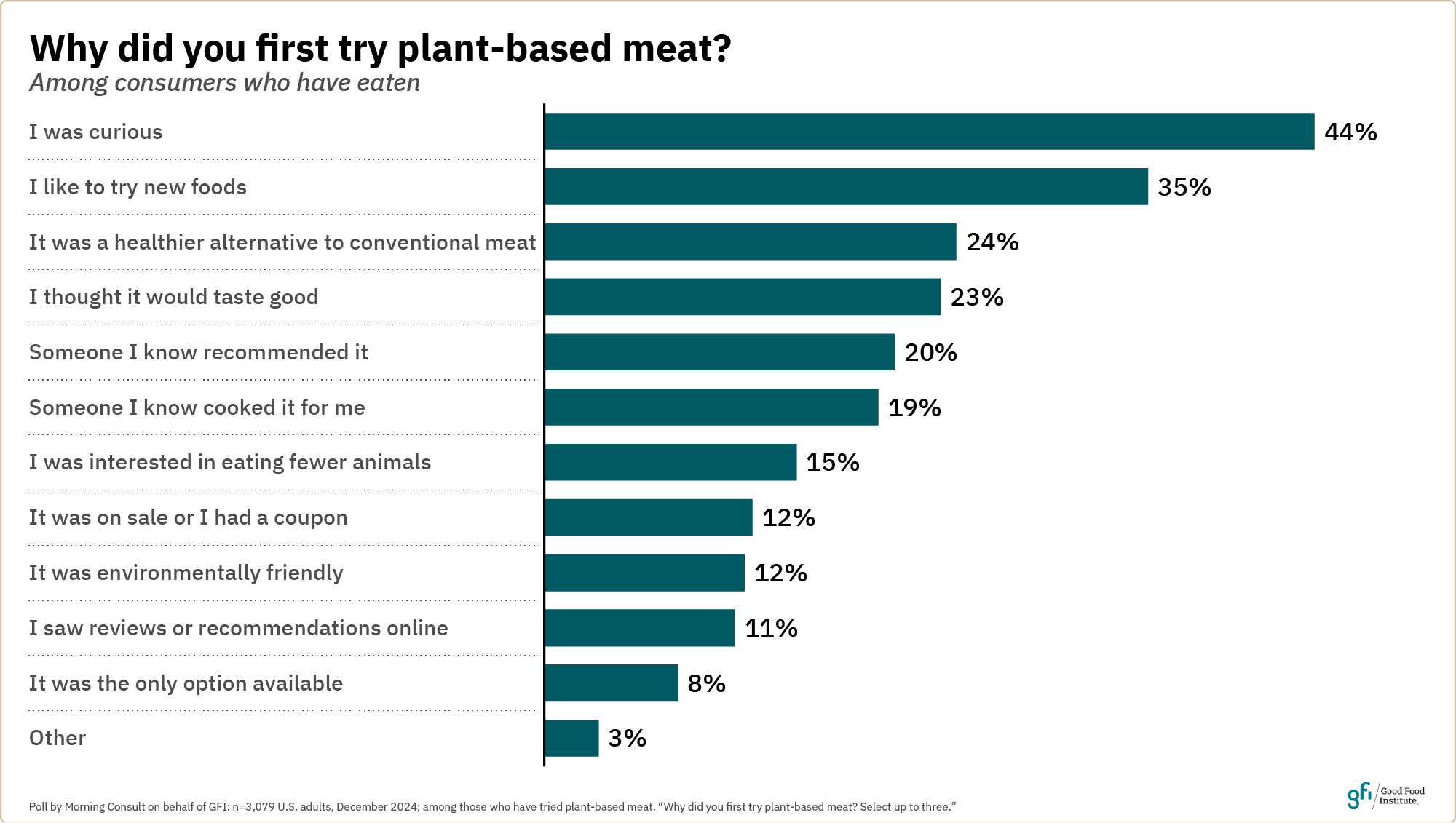
Among consumers who have lapsed or stopped eating plant-based meat in the past year, the top reasons include a preference for animal meat, price, and simply never thinking about it. Indeed, 59 percent of consumers reported hearing “not much” or “nothing at all” about plant-based meat in the past year, and only 10 percent heard “a lot.” Specific concerns with taste and texture are also common reasons consumers cite for no longer eating plant-based meat.
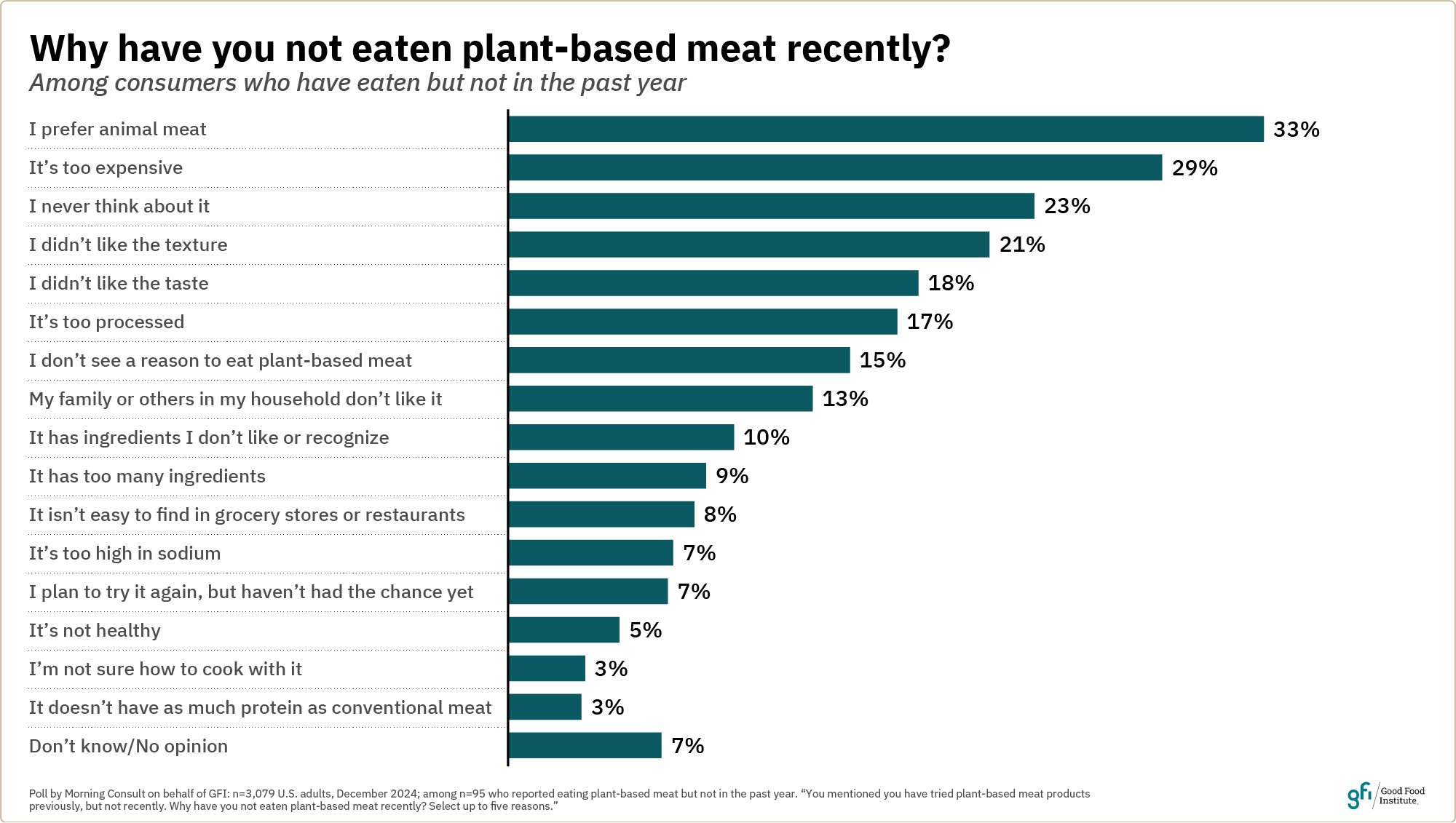
Similarly, for those who have never tried plant-based meat, the primary reasons they report for not doing so are a preference for animal meat, a perception that the products would not taste good, price, and simply not seeing a reason.
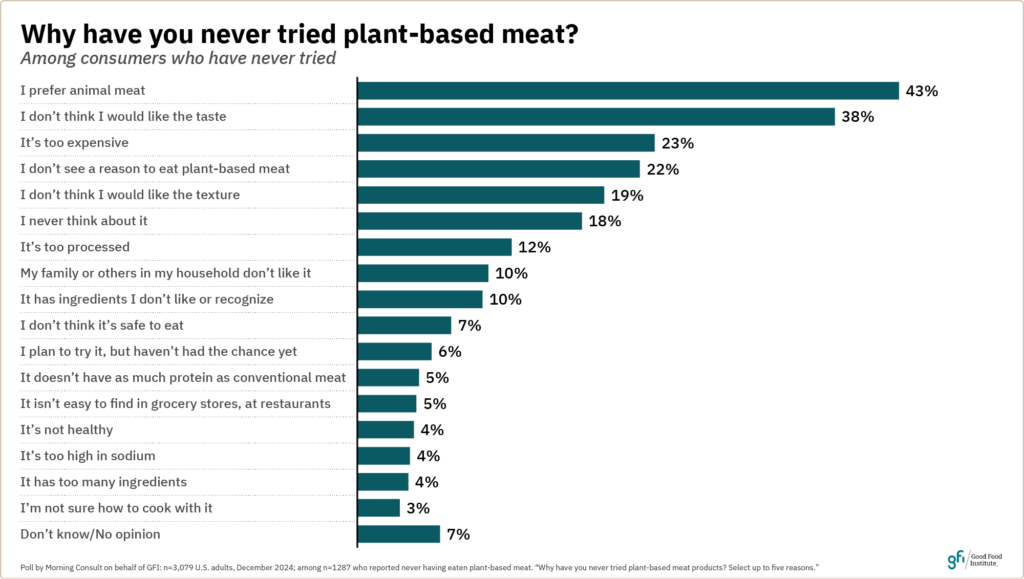
A GFI consumer segmentation study conducted in 2024 found that improvements in price, taste, and texture were the top factors consumers say would make them likely to purchase (or purchase more) plant-based meat. However, the level of relevance did vary by consumer segment, with some segments reporting other factors that were more significant, including improved perceptions of certain health attributes.
These findings demonstrate the challenges the plant-based meat market faces in meeting the needs of consumers who are open to trying the products. It’s clear that there’s an opportunity for the category to better deliver on price, taste, and texture, as well as more strongly establish the value proposition of swapping out a conventional meat product with a plant-based meat product. To the extent that the switching proposition is health, it’s also critical to understand the specific attributes of health that resonate most and those that may present barriers (for example, level of processing, ingredients, or protein content) among different consumer segments.
For more consumer insights, see our latest State of the Industry Report: Plant-based meat, seafood, eggs, and dairy, our Plant-Based Meat Consumer Segmentation, and our Consumer Snapshot: Plant-based meat in the U.S.

Foodservice
The state of plant-based meat and seafood goes beyond the U.S. retail channel. We also track U.S. broadline distributor sales to foodservice operators, which account for a significant portion of total plant-based meat and seafood sales.
U.S. foodservice sales
According to data from Circana, in 2024, plant-based proteins were worth $289 million in broadline distributor foodservice sales (a segment that represents about 42 percent of total foodservice). Dollar sales fell five percent, and pound sales fell four percent in 2024. The category is down slightly from 2022 highs that marked the foodservice sector’s recovery from the COVID-19 pandemic.
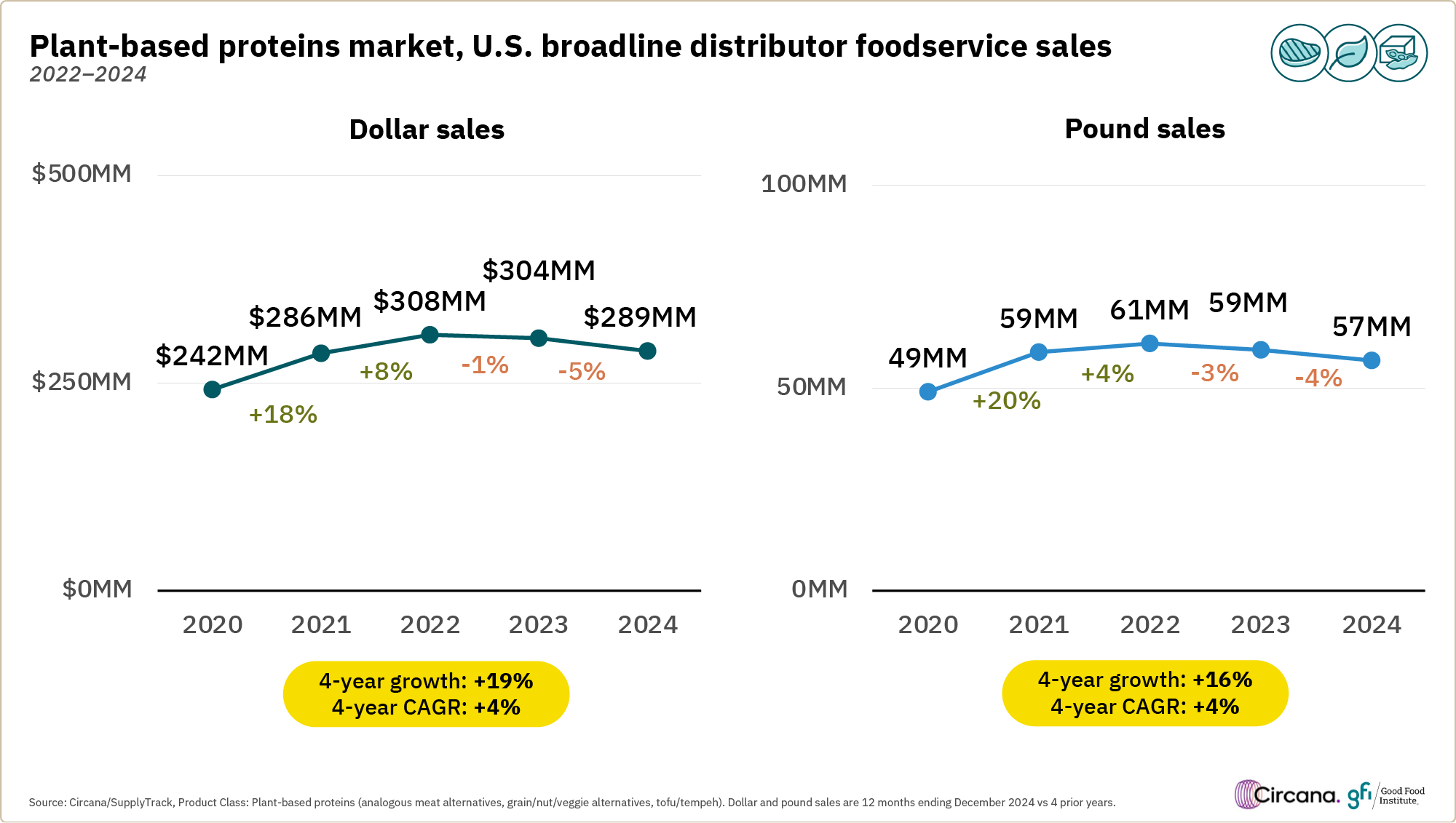
This plant-based protein category is composed of:
- Analog plant-based meat and seafood products meant to replicate the sensory experience of conventional meat. These products experienced sales declines in 2024, with pound sales down 9%. However, they continue to account for the largest share of the plant-based protein market, contributing 56% of pound sales. While overall analog sales were down, there were pockets of growth. Plant-based pork experienced increases in dollar and pound sales and reached a 10% pound share of the plant-based protein market. Some formats also experienced growth, including tenders and links. Plant-based beef remained the largest analog segment, accounting for about a third of all plant-based protein pound sales.
- Tofu and tempeh. Pound sales of tofu and tempeh increased by 6% in 2024 and accounted for about a third of plant-based protein pound sales.
- Grain/nut/veggie items such as black bean burgers. Sales of these products have declined slightly in recent years and accounted for only a small portion of plant-based protein pound sales in 2024.
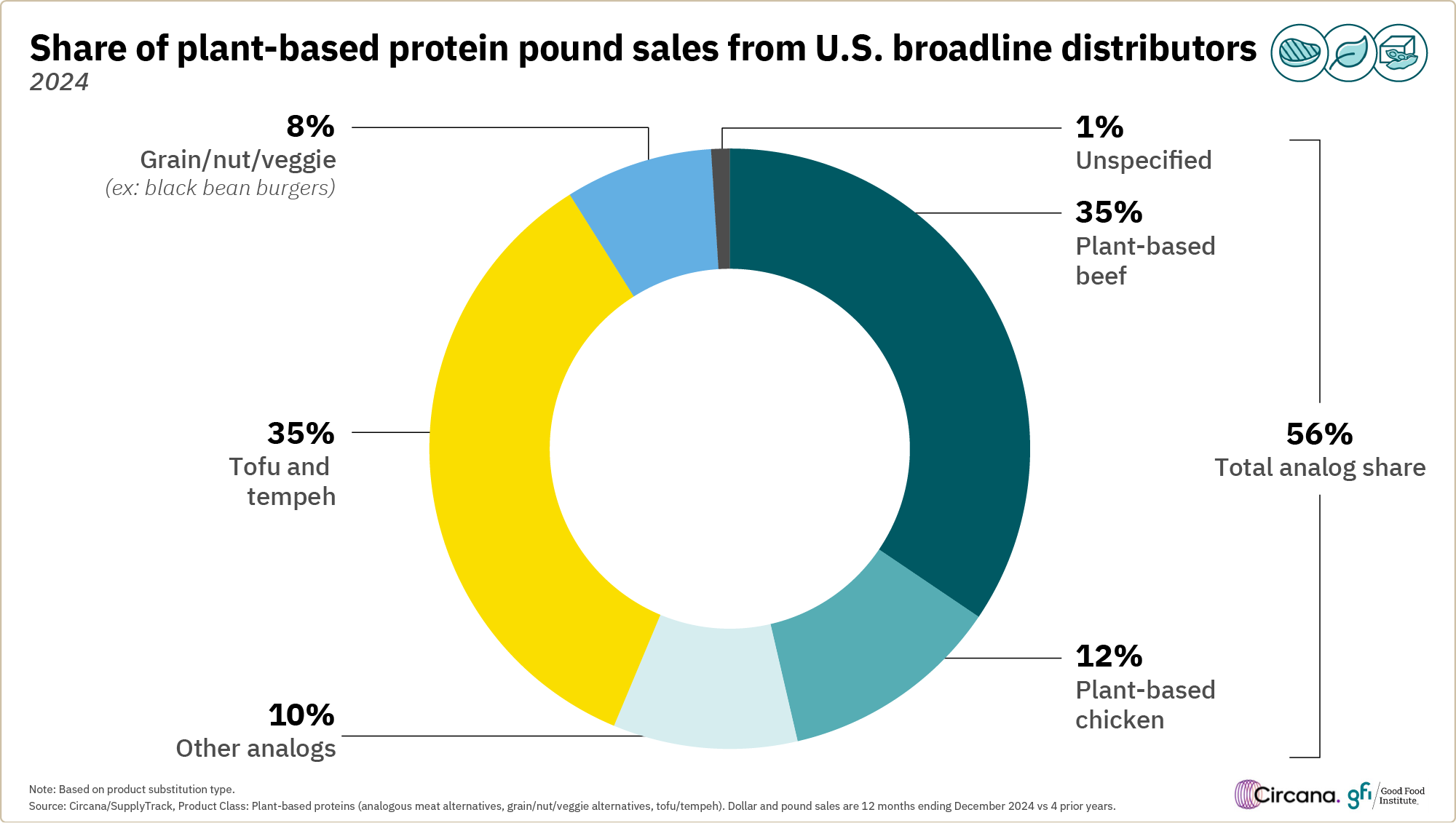
Note: Product substitution classifications (analog, tofu and tempeh, grain/nut/veggie) were re-evalutated by Circana in the latest data set and adjusted to reflect how products are being marketed by distributors. Therefore, the current product substitution sales breakdown should not be compared with previously published annual reports.

Global
According to estimates from Euromonitor, the U.S. accounted for about 25 percent of global plant-based meat and seafood retail sales in 2024. Europe was the largest market for plant-based meat and seafood, contributing 54 percent of retail sales.
Global retail sales
Euromonitor estimates that global plant-based meat and seafood retail sales (excluding tofu and tempeh) were $6.1 billion in 2024. Sales were up slightly from 2023, driven largely by growth in Europe.

According to Euromonitor estimates, Europe and North America made up nearly 85 percent of total retail sales for plant-based meat and seafood in 2024 while other regions like Latin America, APAC, the Middle East, and Africa remained emerging markets for the category. For these regions, growth and expansion of the category are often tied to early distribution growth, while larger markets like Europe and North America have experienced a more complex environment in recent years.
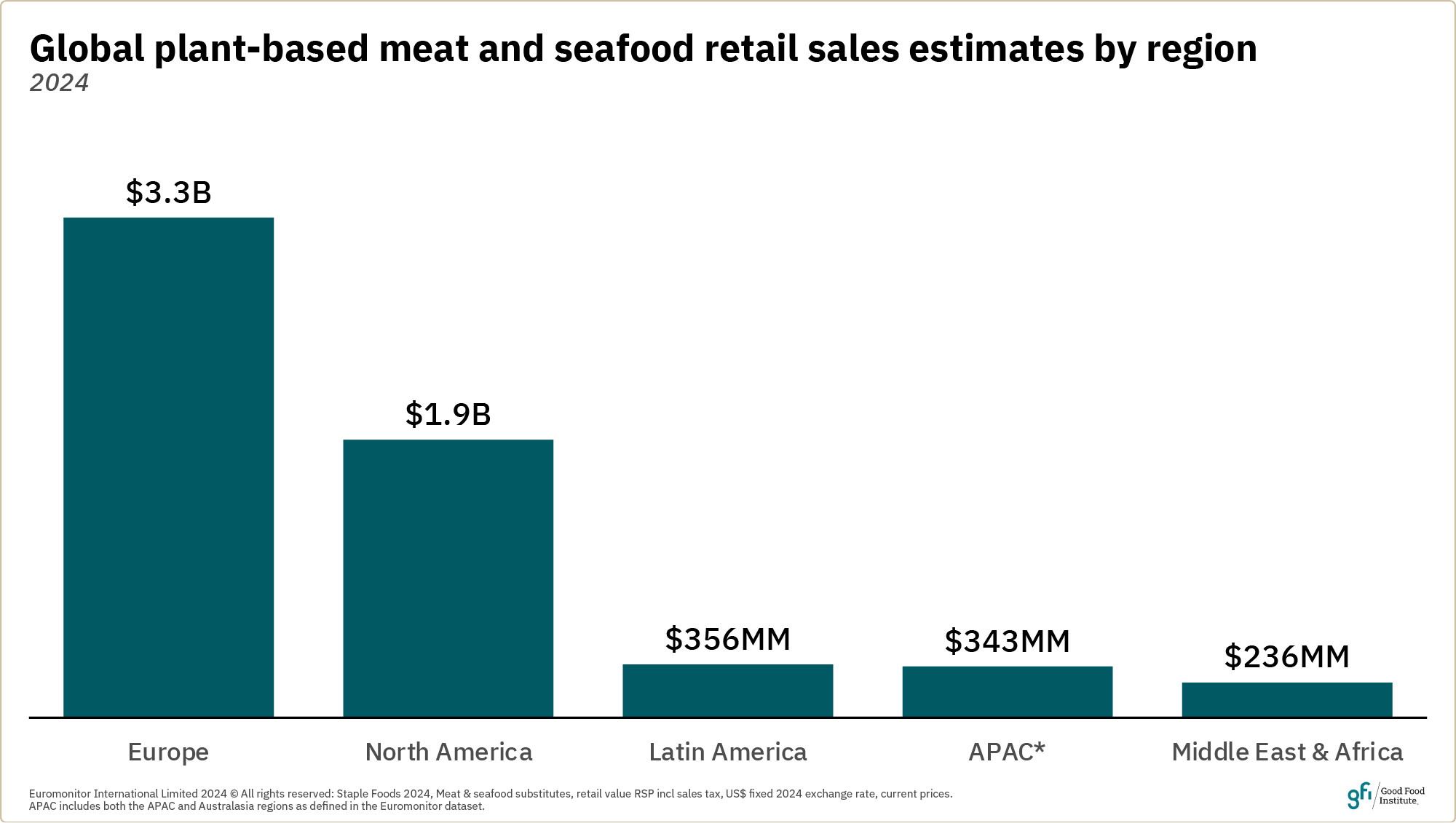
Price and retail innovations in the European plant-based meat market
The European plant-based meat market has shown more resilience than the U.S., likely buoyed by price improvements and retailer innovations. According to GFI Europe’s sales data from Circana, the retail market for plant-based foods across four key European markets grew in value in 2024, although sales did decline in some countries.
Germany, Europe’s largest plant-based market, continues to see growth overall, particularly in private label products (where plant-based milk and drinks are now cheaper per liter than their dairy equivalent), alongside declines in recent years in some other markets such as the UK, where research by New Food Innovation found that most types of plant-based meat were still priced higher than their conventional counterparts.
Retailers in Europe have also made strides in pricing and merchandising plant-based meat that have been shown to drive consumer purchasing:
- Austria-based Billa saw a 33% increase in sales of their private-label plant-based products priced at parity to or lower than their conventional counterparts, with meat analogs among their top-selling private-label plant-based items.
- German chain Lidl reported sales of plant-based products from its private-label Vemondo range rose more than 30% after bringing down the cost to match their animal-based equivalents.
- In the Netherlands, Lidl sold an average of 7% more meat substitutes during an integrated merchandising pilot in 70 stores.
Public commitments by several large retailers in Europe to increase plant-based food sales are expected to motivate further innovation.
Explore global deep dives
For regional deep dives and insights on trends around the world in plant-based meat and seafood, check out the following resources.

Emerging areas and opportunities
The plant-based meat and seafood category in the U.S. has faced a challenging environment in recent years, but opportunities in consumer engagement and product innovation have the potential to return the category to sustained growth.
Consumer interest and growth levers
Despite recent challenges, there are signals of strong consumer interest in plant-based meat and seafood and several levers to increase consumer engagement in the category.
- Many consumers express openness to plant-based meat, particularly younger consumers. In the GFI consumer segmentation study, over two-thirds of U.S. consumers aged 18 to 59 said they are open to consuming plant-based meat in the future. Plant-based meat appeal is not limited to vegetarians and vegans or even to flexitarians. A majority of self-identified omnivores–representing about two-thirds of the population surveyed–are also interested and recognize various benefits to adding plant-based meat to their diets, like health and nutrition. This dynamic signals a significant opportunity for plant-based meat—but only if the products can fully meet the needs of these consumers.
- Taste and price are table stakes that, if improved, will attract consumers. The primary barriers holding many consumers back from purchasing plant-based meat and seafood products are taste and price. Among consumers who have eaten plant-based meat previously but not in the past year, 36% say they would repurchase if a plant-based meat product had the exact taste and texture of conventional meat, and 35% say they would repurchase if it cost less than conventional meat (survey conducted by Morning Consult on behalf of GFI in December 2024). With continued private and public investment, research and development, and product innovation, the plant-based meat industry can overcome these barriers to unlock greater potential in this category.
- Health and social factors can be compelling differentiators. Health is a top factor for many consumers when choosing their food. According to a survey conducted by Morning Consult on behalf of GFI in December 2024, more than half of consumers see plant-based meat as a healthy option. In the GFI consumer segmentation study, segments of consumers most open to plant-based meat also attributed specific, relevant health attributes to plant-based meat. Those included being low fat, low cholesterol, high protein, offering vitamins and minerals, and lacking hormones and steroids. Additionally, while sustainability and animal welfare may not be primary motivators for most consumers to change their behavior regarding conventional meat consumption today, many consumers express awareness of these issues, and there may be opportunities to tap into this latent concern.
- Room to grow with current consumers. In the GFI consumer segmentation study, past-year plant-based meat consumers reported eating the products only about two to three times a month on average. Household purchase data from SPINS shows that 96% of plant-based meat buyers also purchased animal meat. Among those households, they spent an average of $51 on plant-based meat and seafood, a small portion of the $683 they spent on all conventional and plant-based meat. Looking at this another way, a recent NielsenIQ Migration study commissioned by GFI found that if sales from medium-engaged plant-based meat and seafood purchasing households matched their category purchases to the top-engaged households, the plant-based meat and seafood category would grow by an estimated 70%. This highlights the significant opportunity to address the range of needs among current plant-based meat buyers and capture a larger share of their total meat purchases and occasions.
- Opportunities to build awareness and familiarity. A December 2024 survey conducted by Morning Consult on behalf of GFI showed that 32% of U.S. adults had never heard of plant-based meat (or were unsure), and 47% had never tried it (or were unsure). Only 10% claimed to have seen, read, or heard “a lot” about plant-based meat in the past year; another 31% claimed to have heard “some.” Among consumers who had eaten plant-based meat but not in the past year, 23% indicated a top reason is that they “never think about it.” This highlights the opportunity to build category-level awareness and keep plant-based meat at the top of consumers’ minds, along with establishing a more resonant value proposition.
Product renovation and innovation
Continuing to invest in innovation, product development, and product renovation can ensure that more and better products reach consumers looking for options that deliver on taste, texture, and experience. Research from NECTAR provides insight into the progress current plant-based meat products have made on sensory attributes and where there remain opportunities to improve. The potential of plant-based meat products to achieve comparable levels of sensory appeal to conventional counterparts has been demonstrated by plant-based chicken nuggets, which have been shown in at least two sensory studies to have narrowed or closed the taste gap.
Some examples of focus areas for continued sensory improvement include:
- Formulating products to achieve better flavor intensities and authentic meat flavor profiles.
- Ensuring products have a low background flavor that does not distort subtler conventional meat, poultry, and seafood flavors.
- Accurately representing textures and ensuring they have the right balance of softness versus hardness, mouthfeel, and authentic bite-down.
- Further researching and experimenting with base plant ingredients. Currently, the vast majority of plant-based meat and seafood products leverage just a handful of plant protein bases such as soy, pea, and wheat. Additional research into other plant-protein bases could lead to better-optimized ingredients and improved product performance. Additionally, novel plant ingredients like jackfruit offer the potential to deliver new taste and texture experiences for consumers.
- Exploring alternative fats. Innovative plant-based fat ingredients or cultivated or fermentation-enabled fats could advance the aroma, juiciness, tenderness, and overall mouthfeel of plant-based meat and seafood products. Fats are also an important ingredient that can add to (or detract from) consumer’s overall expectations of the taste and health attributes of plant-based meat products.
NECTAR provides additional product development guidance on specific sensory attributes, which vary across categories.
While looking for opportunities to optimize taste and texture, it will be important to remember that health benefits are an important part of the value proposition for key segments of consumers. These consumers may be interested in product renovations that—without sacrificing taste—deliver cleaner ingredient labels and improved health and nutrition benefits, including optimizing levels of nutrients like protein, sodium, or fiber.
Other alternative protein ingredients and platforms
Increasingly, products that combine ingredients from across alternative protein production platforms are coming to market. An example of this is the Impossible Burger. Impossible Foods incorporates soy leghemoglobin produced via precision fermentation into their plant-based burger to give the finished product a meaty taste and appearance. Products like this have the potential to leverage the best components of plant-based, fermentation, and cultivated technologies to improve taste, texture, and/or cost. The relative affordability of plant-based products compared to other alternative proteins today makes them particularly suitable to combine with fermentation-derived or cultivated ingredients in order to produce high-performing products at lower costs.
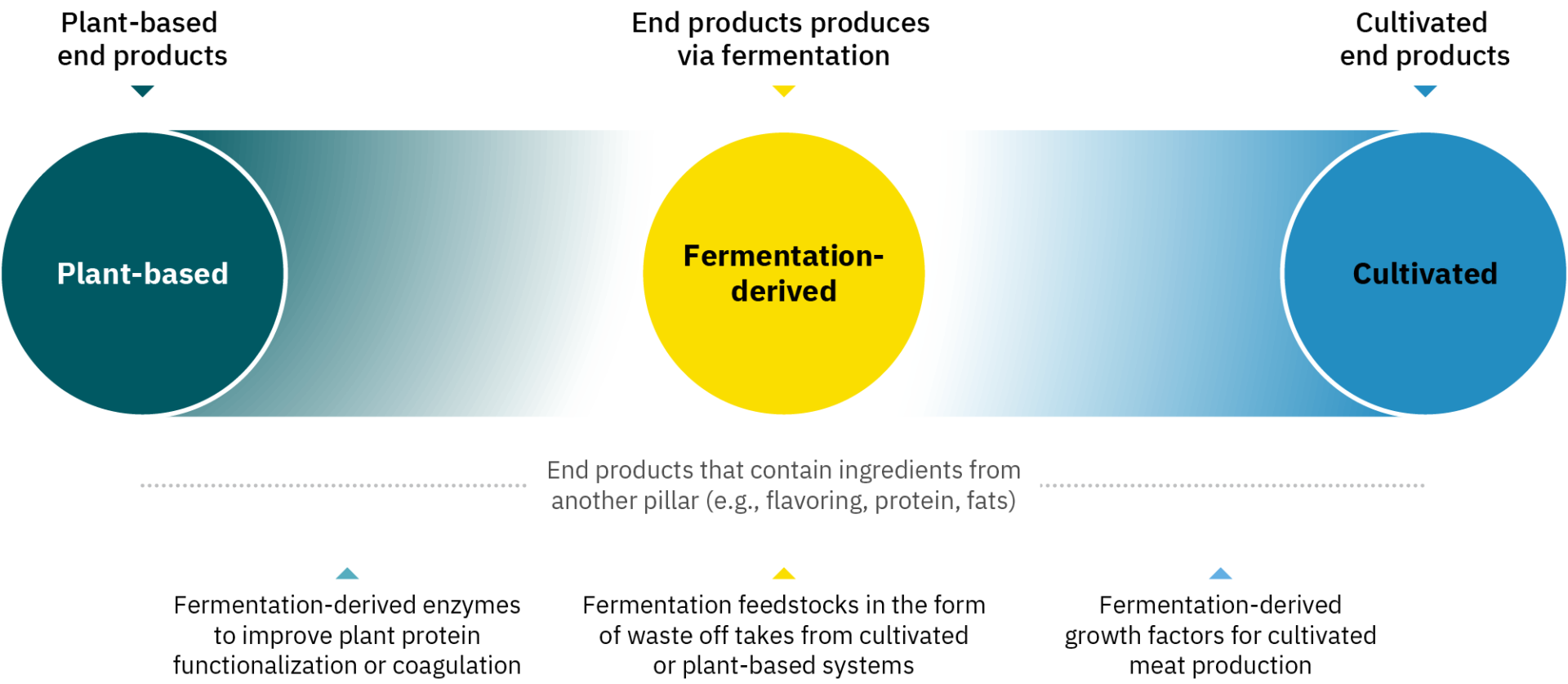
In recent years, biomass fermentation has been the basis for the expansion of alternative protein offerings in formats like filets, steaks, and cutlets that can act as a direct swap for whole-cut center-of-plate animal products. This is an area where fully plant-based products have traditionally been underrepresented. Fermentation technology also expands the possibilities for alternative proteins to match the texture characteristics of conventional meat, an attribute many consumers indicate is comparably important to taste.
Products in which some amount of conventional meat is reduced in favor of plant-based (or other alternative protein) ingredients also present a potential opportunity to serve as an entry point for consumers looking to reduce conventional meat consumption. One product type on the market today is blended animal-based and plant-based items that largely target parents who want to incorporate more vegetables into their children’s meals while still providing a familiar product (like nuggets) that children find appealing. GFI’s Category update on blended meat further covers this nascent category.
Building toward price parity
In the current economic environment, affordability looms large for consumers. While inflation eased in 2024, consumers remain concerned and frustrated about grocery costs. They consistently indicate that price is a top barrier to trying or continuing to purchase plant-based meat, which is typically priced at a significant premium. Indeed, among consumers who have eaten plant-based meat previously but not in the past year, 35 percent say they would repurchase if it cost less than conventional meat (survey conducted by Morning Consult on behalf of GFI, December 2024).
To compete with conventional products and lower the barriers to entry and adoption, alternative proteins must be affordable enough to unlock the largest market of consumers: meat-eaters. Reducing the price gap will require public and private investments to scale up plant-based meat and seafood production, reduce the costs of goods and services, and, ultimately, reach consumers who cannot afford to sacrifice value.
Brands may consider efforts to move towards price parity, such as refining and consolidating their flavor formulations, increasing product shelf life, and more fully utilizing their sidestreams to reduce production costs. Looking ahead, an economic environment with less pricing pressure could also be a release valve for the category.

Future outlook
The plant-based meat and seafood category in the U.S. has faced some challenges in recent years, yet opportunities in product innovation and consumer engagement have the potential to return the category to sustained growth.
The future success of the plant-based meat sector in motivating consumers to switch from conventional meat is not inevitable—yet the current challenges are clear, solvable market challenges. Through continued product innovation, increased public and private investment, and market-wide efforts to better reach consumers, plant-based meat can overcome these barriers and transition from niche to norm.
Compared to conventional meat, plant-based meat and seafood provide clear benefits—environmental benefits like reductions in greenhouse gas emissions and land and water use, public health benefits like lower antibiotic use, and personal health benefits like consuming more plants, more fiber, and less cholesterol. Younger generations report valuing these drivers even more than the general population, indicating a market opportunity as they continue to come into their buying power. While such aspirational drivers have contributed to record activity in the plant-based meat and seafood category in the last decade, in recent years, inflationary pressures, price premiums, and difficulties in meeting consumer needs contributed to U.S. retail sales headwinds. The switching cost for consumers is still too high.
Yet this is against a backdrop of significant potential and strong consumer tailwinds. Currently, taste and price performance limit the category’s engagement with consumers. U.S. consumers say they’d be more willing to eat plant-based meat and seafood if it tasted better, was more affordable, and offered relevant and differentiated benefits. The industry can overcome these issues with increased R&D, product development and renovation, and improved marketing and consumer education. If the products can taste as good or better and cost the same or less compared to conventional products, consumers will have a lower barrier to entry for acting upon aspirational benefits, and the vast market potential could be unlocked.
Companies can lead by increasing investment in R&D to deliver tasty, affordable products that appeal to mainstream meat-eaters interested in eating plant-based foods. The research community can lead by encouraging more scientists from diverse disciplines and tenures to jump into the alternative protein field and by providing open-access research to advance the entire sector. Governments can lead by funding critical R&D to advance the science, providing manufacturing incentives to help scale up, and supporting regulations that provide a level playing field to allow plant-based meat and seafood to compete on taste, price, and convenience. Doing so can address the industry’s biggest sensory and technical challenges, inspire additional research, create new growth opportunities, and ultimately ensure the plant-based meat and seafood category can deliver on its broad public benefits for everyone at the table.
About the data
Point-of-sale data
To size the U.S. retail market for plant-based foods, GFI and PBFA commissioned retail sales data from the market research firm SPINS. The firm built the dataset by first pulling in all products with the SPINS “plant-based positioned” product attribute. The dataset was further edited by adding plant-based private-label products. Inherently plant-based foods, such as chickpeas and kale, are not included. Due to the custom nature of these categories, the retail data presented may not align with standard SPINS categories.
Additionally, SPINS pulled in relevant mainstream subcategories (excluding plant-based positioned products) in order to create the “Conventional” categories discussed. Finally, the total food and beverage category was pulled bringing in all grocery, frozen, and refrigerated edible items across the retail grocery landscape as well as protein powders and bars. SPINS obtained the data over the 52-week, 104-week, and 156-week periods ending December 1, 2024, from the SPINS Natural Expanded Channel and SPINS Conventional Multi-Outlet and Convenience Channels (powered by Circana).
SPINS defines these channels as follows:
- Conventional Multi Outlet (MULO) Channel: More than 110,000 retail locations (powered by Circana) that cover the Grocery Outlet (stores with $2M+ annual ACV), the Drug Outlet (chains and independent stores, excluding Rx sales), and selected retailers across Mass Merchandisers (e.g., Walmart, Target), Club (e.g., Sam’s Club), Dollar, all Military, and Amazon F3 (Fresh, Prime Now, Go).
- Natural Expanded Channel: More than 2,500 full-format stores with over $2 million in annual sales and 30% or more of UPC coded sales from the Health & Wellness Industry (HWI) and 15% or more from the Natural Product Industry (NPI) Product Universes.
- Convenience Channel: More than 150,000 convenience locations (powered by Circana) that are less than 5,000 square feet, have extended hours, stock at least 500 SKUs, and provide a mix of grocery items like beverages, snacks and confections, and tobacco.
This is generally considered the broadest available view of retail food sales, although not all retailers are represented. Some companies do not report their scan data to Circana but are represented via projections. Please note that this study’s methodology has changed compared to that used in previous reporting by GFI. We do not recommend comparing data released in prior years to the data included here.
Consumer panel data
To understand consumer purchasing dynamics and demographics, GFI and PBFA also commissioned consumer panel data from SPINS. The process for pulling the panel data was separate from that for the POS data, which may result in minor category differences. SPINS combines Circana Scan Panel with proprietary Product Intelligence to provide a unique view into shopper incrementality, loyalty, cross-purchase, demographics, and more. SPINS obtained the data over the 52-week, 104-week, 156-week, and 208-week periods ending December 1, 2024, from all U.S. outlets.
About SPINS

SPINS connects shopper values to product innovation by combining POS data across conventional, eCommerce, and natural channels with deep product knowledge. By translating product data into attributes, we ensure retailers, brands, and their partners know just as much about the products they create, stock, and sell as the shoppers that buy them. These attributes create a common language that promotes collaboration and growth across the ecosystem.
Meet the authors

Jody Kirchner
ASSOCIATE DIRECTOR OF MARKET INSIGHTS
Jody Kirchner leads GFI’s market and consumer insights team, delivering data-driven analysis to educate industry leaders and key stakeholders on the opportunities around alternative proteins.
Areas of expertise: consumer insights, market research & analysis, growth strategy, innovation, food industry

Daniel Gertner
LEAD ECONOMIC AND INDUSTRY ANALYST
Daniel analyzes the alternative protein industry landscape and identifies gaps and opportunities in the sector.
Areas of expertise: alternative protein market landscape, research and analysis, food and agricultural economics

Taylor Leet-Otley
CONSUMER RESEARCH LEAD
Taylor Leet-Otley oversees GFI’s consumer research, keeping the organization and the industry in touch with consumers’ needs & beliefs in the fast-moving alternative protein category.
Areas of Expertise: Consumer insights, market strategy, branding & marketing

Emma Ignaszewski
DIRECTOR OF CORPORATE ENGAGEMENT
Emma Ignaszewski oversees the corporate engagement team’s direct outreach group.
We conduct research and share insights to educate the public on alternative proteins and champion their adoption by the food industry, including manufacturers, retailers, restaurants, investors, and more. By 2050, the global demand for meat is projected to rise significantly. By reimagining how meat is made, we can meet consumers where they are. Our work makes it possible for alternative proteins to increasingly compete with conventional meat, seafood, eggs, and dairy on the key drivers of consumer choice: taste, price, and convenience. We analyze the market, uncover consumer insights, identify AP white spaces and opportunities, and build the community.
Areas of expertise: alternative protein industry landscape, market insights and consumer research, strategic engagements with companies, marketing & communications, alt protein sustainability & climate impacts.











